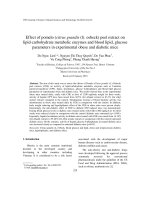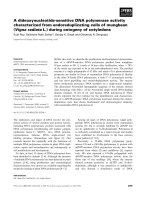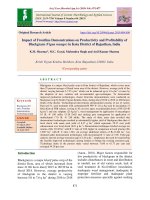Effect of phosphorus and bio-fertilizers on yield, nutrient content and uptake of urban [Vigna mungo (l.) Hepper]
Bạn đang xem bản rút gọn của tài liệu. Xem và tải ngay bản đầy đủ của tài liệu tại đây (122.2 KB, 8 trang )
Int.J.Curr.Microbiol.App.Sci (2017) 6(5): 2144-2151
International Journal of Current Microbiology and Applied Sciences
ISSN: 2319-7706 Volume 6 Number 5 (2017) pp. 2144-2151
Journal homepage:
Original Research Article
/>
Effect of Phosphorus and Bio-fertilizers on Yield, Nutrient Content and
Uptake of Urban [Vigna mungo (l.) Hepper]
Maya Yadav1, S.S. Yadav, Sunil Kumar2*, Hansa Kumari Yadav and Pradip Tripura3
1
Department of Agronomy, S.K.N. college of Agriculture, SKNAU Jobner- 303329
2
Department of Agronomy, IAS, BHU, Varanasi-221 005, India
3
Department of Soil Science and Agricultural Chemistry JAU, Junagharh, India
*Corresponding author
ABSTRACT
Keywords
Phosphorus,
Phosphorus
Solubilizing bacteria,
Vesicular arbuscular
mycorrhiza,
Nutrient uptake and
yield
Article Info
Accepted:
19 April 2017
Available Online:
10 May 2017
A field experiment was conducted during Khari season of 2014 on loamy sand soil
to study the effect of phosphorus levels and bio-fertilizers on productivity, nutrient
content and uptake of urban. Experiment consisted of four treatments of
phosphorus levels (0, 20, 40 and 60 kg/ha) and four treatments of bio-fertilizers
(control, PSB, VAM and PSB + VAM) thereby making sixteen treatment
combinations tested in randomized block design with three replications. Result
indicated that application of phosphorus up to 40 kg/ha significantly increased
grain and straw yield, net returns, protein content in grain, nitrogen, phosphorus
and potassium concentration in grain and straw and total uptake of nitrogen,
phosphorus and potassium over preceding levels and remained at par with 60
kg/ha. Whereas, raising the level of phosphorus from 0 to 20 kg/ha registered the
highest agronomic efficiency, apparent recovery and physiological efficiency of
phosphorus after that, it showed significant decline up to 60 kg/ha. Combined
inoculation of seed and soil with PSB + VAM significantly increased the grain and
straw yield, net returns, nitrogen, phosphorus and potassium concentration in grain
and straw, their total uptake as well as protein content in grain and available
phosphorus in soil after crop harvest over PSB, VAM and control, whereas, the
highest agronomic efficiency and apparent recovery of P recorded under PSB +
VAM inoculation and physiological efficiency under control.
Introduction
Pulses are the main source of dietary protein
particularly for vegetarians and contribute
about 14 per cent of the total protein of
average Indian diet. Urdbean [Vigna mungo
(L.) Hepper] is among the major pulses grown
throughout the country during both in summer
and rainy season. It is a self pollinated
leguminous crop containing 24% protein. The
duration of the crop is very short; it fits well
in various multiple and intercropping systems.
After removing pods, its plant may be used as
good quality green or dry fodder or green
manure. Being a legume, it also enriches soil
by fixing atmospheric nitrogen. Phosphorus is
a universally deficient plant nutrient in most
of the soils of Rajasthan, particular in light
textured soils. Application of phosphorus to
pulse crop has been found very effective and
2144
Int.J.Curr.Microbiol.App.Sci (2017) 6(5): 2144-2151
called as master key element for increasing
yield. its play a vital role in growth and
development of roots, phosphorus is also
necessary for growth of Rhizobium bacteria
responsible for biological fixation of N to
increase the efficiency of pulses as soil
renovator and serves the dual purpose of
increasing yield of main as well as succeeding
crop. An adequate supply of phosphorus has
been reported good for better growth, yield,
quality and enormous nodule formation in
legumes (Sammauria et al., 2009). It acts as a
structural component of membrane system of
cells, chloroplasts and mitochondria. It is a
constituent of energy phosphates like ADP
and ATP, nucleic acids (DNA and RNA),
nucleo
proteins,
purines,
pyrimidine,
nucleotides and several coenzymes. About
93-99 per cent of the total phosphorus is
insoluble and hence directly not available to
plants. Inoculation of P solubilizing
microorganisms in the rhizosphere of crop
and soil increases the availability of P from
insoluble sources of phosphate, desorption of
fixed phosphates and also increases the
efficiency of phosphatic fertilizers through
secreting acidic substances (Gaur, 1991).
Symbiosis between plant roots and certain
soil fungi e.g. Vesicular Arbuscular
Mycorrhiza (VAM) plays an important role in
phosphorus cycling and its uptake by plants
(Biswas et al.,(2001). These symbiotic microorganisms have extensive mycelial network
and can increase the transport of other mineral
elements such as zinc and copper. VAM fungi
can play an important role in enhancing P
availability to plants in deficient soils and can
save P-fertilizer by 25-30% (Somani et al.,
1990).
Materials and Methods
A field experiment was conducted during
kharif season of 2014 at the Agronomy Farm,
S.K.N. College of Agriculture, Jobner
(Rajasthan). Soil of the experimental field
was loamy sand in texture with alkaline in
reaction (pH 8.2), low in organic carbon
(0.14%) and available nitrogen (137.4 kg/ha),
medium in available phosphorus (16.2 kg/ha)
and potassium (154.2 kg/ha). Experiment was
laid out in randomized block design with
sixteen treatment combinations comprised of
four phosphorus levels (0, 20, 40 and 60
kg/ha) and four treatments of bio-fertilizers
viz., (control, PSB, VAM and PSB + VAM).
The urdbean variety T-9 was sown using seed
rate 15 kg/ha with a row spacing of 30 cm at
the depth of 4-5 cm. Seeds were treated with
PSB culture using three packets (200 g each)
for 15 kg of seed of urdbean needed for
sowing for one hectare and VAM was applied
as per treatments to the open furrow using
field soil to bulk the carrier. Uniform dose of
nitrogen 25 kg/ha was applied to all the plots
by adjusting the nitrogen supplied by DAP
and remaining through urea at the time of
sowing. Whereas, phosphorus was applied as
per treatments through DAP. N concentration
was determined by modified Kjeldahl method
while total P determined using sulphuricnitric-perchloric acid digest procedure. K was
determined by tri acid digestion procedure on
flame photometer.
Results and Discussion
Effect of phosphorus levels
Successive increase in phosphorus levels
significantly increased number of pods/plant,
number of grains/pod, test weight, grain yield,
straw yield and biological yield up to 40
kg/ha, which was comparable with
application of highest level of 60 kg/ha and
no significant effect was observed on harvest
index (Table 1). The increase in grain yield
with 60 kg/ha was 13.9 and 51.2% over 20
kg/ha and control, respectively. This could be
attributed due to better root proliferation,
higher
root
development,
increased
availability and uptake of nutrients, energy
transformation and metabolic processes in
plant.
2145
Int.J.Curr.Microbiol.App.Sci (2017) 6(5): 2144-2151
Table.1 Effect of phosphorus fertilization and bio-fertilizers on yield attributing characters, grain, straw,
biological yield, harvest index and net returns
Number of
grains/pod
Test
weight
(g)
Grain
yield
(kg/ha)
Straw
yield
(kg/ha)
Biological
yield
(kg/ha)
Harvest
index (%)
Net
returns
(Rs/ha)
A. Phosphorus levels (kg/ha)
Control
16.60
20
22.70
40
27.20
60
28.80
SEm+
0.62
CD (P=0.05)
1.80
5.90
7.10
7.80
8.20
0.18
0.52
34.20
37.10
38.60
39.85
0.93
2.68
784
1041
1160
1186
25
71
1561
2062
2340
2394
49
141
2345
3103
3500
3580
78
226
33.46
33.93
33.17
33.27
1.13
NS
27489
41021
47003
47458
1113
3213
B. Bio-fertilizers
Control
PSB
VAM
PSB + VAM
SEm+
CD (P=0.05)
CV (%)
6.54
7.18
7.37
7.92
0.18
0.52
8.66
34.46
37.29
37.62
40.38
0.93
2.68
8.57
926
1062
1039
1144
25
71
8.15
1882
2114
2080
2281
49
141
8.1
2808
3176
3119
3425
78
226
8.67
33.13
33.69
33.51
33.51
1.13
NS
11.70
34606
42047
40231
46087
1113
3213
9.46
Treatments
Number of
pods/plant
19.23
24.01
23.90
28.15
0.62
1.80
9.04
2146
Int.J.Curr.Microbiol.App.Sci (2017) 6(5): 2144-2151
Table.2 Effect of phosphorus fertilization and bio-fertilizers on N, P, K concentration, protein content and their uptake
Treatments
N concentration
(%)
Total N
uptake
(kg/ha)
Grain Straw
A. Phosphorus levels (kg/ha)
Protein
content
(%)
Grain
P concentration
(%)
Grain
Straw
Total P
uptake
(kg/ha)
K concentration
(%)
Grain
Straw
Total K
uptake
(kg/ha)
Control
3.08
1.42
46.46
19.25
0.352
0.166
5.38
0.765
1.617
31.36
20
40
60
SEm+
CD (P=0.05)
3.43
3.65
3.78
0.07
0.21
1.55
1.67
1.70
0.03
0.10
67.96
81.69
85.87
1.64
4.74
21.44
22.81
23.63
0.45
1.31
0.388
0.415
0.420
0.009
0.026
0.185
0.199
0.210
0.005
0.013
7.90
9.53
10.07
0.23
0.66
0.846
0.899
0.908
0.021
0.061
1.760
1.864
1.877
0.038
0.110
45.27
54.25
55.91
0.70
2.03
B. Bio-fertilizers
Control
3.14
PSB
3.53
VAM
3.48
PSB + VAM 3.79
SEm+
0.07
CD (P=0.05) 0.21
CV (%)
7.21
1.43
1.60
1.59
1.71
0.03
0.10
7.56
56.67
72.15
70.05
83.11
1.64
4.74
8.06
19.62
22.08
21.77
23.66
0.45
1.31
7.21
0.347
0.396
0.397
0.436
0.009
0.026
7.94
0.166
0.191
0.187
0.216
0.005
0.013
8.42
6.41
8.34
8.11
10.03
0.23
0.66
9.65
0.757
0.870
0.867
0.923
0.021
0.061
8.62
1.641
1.796
1.789
1.893
0.038
0.110
7.42
38.25
47.66
46.65
54.23
0.70
2.03
5.22
2147
Int.J.Curr.Microbiol.App.Sci (2017) 6(5): 2144-2151
Table.3 Effect of phosphorus fertilization and bio-fertilizers on phosphorus use efficiency and
available phosphorus in soil after crop harvest
Treatments
Agronomic
efficiency of P
(kg grain/kg P)
A. Phosphorus levels (kg/ha)
Control
20
3.23
40
3.01
60
2.67
SEm+
0.07
CD (P=0.05)
0.20
B. Bio-fertilizers
Control
PSB
VAM
PSB + VAM
SEm+
CD (P=0.05)
CV (%)
2.01
2.24
2.24
2.42
0.07
0.20
10.65
Apparent recovery of P
(%)
Physiological efficiency
of P (kg/kg P)
Available P2O5
(kg/ha)
12.59
10.36
7.81
0.25
0.72
103.22
91.83
91.28
2.09
6.03
15.02
17.10
18.25
18.35
0.35
1.02
8.00
10.41
10.12
12.49
0.29
0.83
11.23
105.61
93.03
93.65
89.47
2.41
6.97
10.11
14.98
17.60
17.44
18.70
0.35
1.02
7.13
2148
Int.J.Curr.Microbiol.App.Sci (2017) 6(5): 2144-2151
The higher crop growth with more supply of
phosphorus might regulate starch/sucrose
ratio in source leaves and reproductive
organs. The beneficial effect of phosphorus
on fruiting of plants and better translocation
of desired metabolites to the yield
contributing parts of the plant might attributed
to more grain yield. The improvement in
straw yield might be due to the fact that
phosphorus tends to increased growth and
development in terms of plant height,
branches and dry matter by improving
nutritional environment of rhizosphere and
plant system leading to higher plant
metabolism and photosynthetic activity.
These findings corroborate the results of
Tanwar et al., (2003), Rathore et al., (2010)
and Kumawat et al., (2013) in urdbean and
Singh and Sekhon (2007) in mungbean. The
application of phosphorus 40 kg/ha recorded
the significantly higher net returns (Rs.
47003/ha) over preceding levels and remained
at par with 60 kg/ha. The increase in net
returns might be due to higher grain and straw
yield obtained under the treatment.
A significant increased protein content in
grain, nitrogen, phosphorus and potassium
concentration in grain and straw and their
uptake were observed with the application of
phosphorus upto 40 kg/ha (Table 2). As stated
that application of phosphorus might have
nutritional environment in rhizospheric as
well as in plant leading to increased uptake
and translocation of nutrients especially of N,
P and K in reproductive structures which led
to higher content and uptake. Further, the
significant and positive correlation of yield
with nutrients also evidenced for higher
content of nutrients. Since, uptake of N, P and
K is the function of grain and straw yield and
their content, the significant increase in
concentration of these nutrients coupled with
increased grain and straw yield enhanced the
total uptake of N, P and K. protein content is
essentially
the
manifestation
of
N
concentration in grain. Hence, increased N
concentration might have increased the
protein content. These results are close in
conformity with the findings of Srinivasarao
and Ali (2006) in urdbean and Kumawat et
al., (2014) in greengram. Raising the level of
phosphorus from 0 to 20 kg/ha registered the
highest agronomic efficiency, apparent
recovery and physiological efficiency of
phosphorus after that, it showed significant
decline up to 60 kg/ha. Whereas, the available
phosphorus in soil after crop harvest
increased significantly upto 40 kg/ha and
remained at par with 60 kg/ha (Table 3).
Effect of bio-fertilizers
Seed or soil inoculation with bio-fertilizers
(PSB, VAM and PSB + VAM) significantly
enhanced the number of pods/plant, number
of grains pod-1, test weight as well as grain
and straw yield of urdbean over no
inoculation and no significant effect on
harvest index (Table 1). The highest values of
these parameters were recorded under
combined inoculation with PSB + VAM that
was accompanied by PSB and VAM, alone.
This could be ascribed to the greater
availability and uptake of phosphorus due to
additive effect of these two bio-fertilizers in
improving nutritional environment enhanced
the growth in terms of branches and dry
matter, photosynthetic area, production of
assimilates and their translocation to
reproductive structures, thereby increasing the
yield attributes and ultimately, yield of the
crop. Significant increase in straw yield due
to bio-fertilizer inoculation could be attributed
to the increased vegetative growth possibly as
a result of effective utilization of nutrients
absorbed through extensive root system and
prolific shoot development on account of
improved nourishment. These results are in
close conformity with the findings of Biswas
and Patra (2007) in greengram and Tomar et
al., (2001), in urdbean. Dual use of PSB
+VAM fetched significantly highest net
2149
Int.J.Curr.Microbiol.App.Sci (2017) 6(5): 2144-2151
returns (Rs. 46087/ha) in comparison to rest
of the treatments. PSB and VAM also gave
16.2 and 21.5 per cent more return than
control and thus found the next better and
equally effective treatments.
Combined inoculation with PSB + VAM
significantly enhanced the N, P and K
concentration in grain and straw, their total
uptake as well as protein content in grain over
untreated control (Table 2). The highest
concentration and uptake were noted to be in
PSB + VAM treated plots. This occurs due to
increased solubilization and mineralization of
organic phosphorus and availability of
nitrogen and phosphorus (Kumar et al., 2014).
Phosphorus concentration in soil after harvest
of crop increased significantly due to
inoculation with PSB + VAM. It might be due
to build up of nutrients in soil. Dual
inoculation of seed and soil with PSB + VAM
recorded significantly highest agronomic and
apparent recovery than rest of the treatments,
whereas, the highest physiological efficiency
recorded under control (Table 3).
References
Biswas, A. and Patra, A.P. 2007. Study on the
effect of phosphorus, Vesicular
ArbuscularMychorrhyza (VAM) and
Phosphate Solubilizing Bacteria (PSB)
on the performance of summer
greengram. (In)National Symposium on
Legumes for Ecological Sustainability:
Emerging
Challenges
and
Opportunities held during 3-5 Nov.
2007 at Indian Institute of Pulses
Research, Kanpur.
Biswas, B.C., Das, S. and Subhash, K.P.
2001. Crop response to bio-fertilizers.
Fertilizers News, 46: 15-24.
Gaur, A.C. 1991. Phosphate solubilizing
micro-organism and bio-fertilizers.
Omega Scientific Publishers, New
Delhi, 176.
Kumar, S., Tomar, S. and Tomar, T.S. 2014.
Integrated phosphorus management in
blackgram (Vignamungo) in western
utter pradesh during summer season.
Annals of Agriculture Res., 5(3): 290297.
Kumawat, P.K., Tiwari, R.C., Golada, S.L.,
Garhwal, R.K. and Choudhary, R. 2013.
Effect of phosphorus sources, levels and
bio-fertilizers on yield attributes, yield
and
economics
of
blackgram
(Phaseolusmungo) Legume Res., 36: 7073.
Kumawat, S.R., Khistriya, M.K., Yadav, S.L.
and Kumar, M. 2014. Effect of
phosphorus fertilization on yield,
nutrient content, uptake and quality of
summer greengram [Vignaradiata(L.)
Wilczek]. Environ. Ecol., 32(2A): 785788.
Rathore, D.S., Purohit, H.S. and Yadav, B.L.
2010.
Integrated
phosphorus
management on yield and nutrient
uptake of urdbean under rainfed
conditions of Southern Rajasthan, J.
Food Legumes, 23(2): 128-137.
Sammauria, R., Yadav, R.S. and Nagar, K.C.
2009. Performance of clusterbean
(Cyamopsistetragonoloba) as influenced
by nitrogen and phosphorus fertilization
and biofertilizers in Western Rajasthan.
Indian J. Agron., 54(3): 319-323.
Singh, G. and Sekhon, H.S. 2007. Effect of
sowing
methods
and
fertilizer
application on growth and yield of
kharif
mungbean
(In)
National
Symposium on Legumes for Ecological
Sustainability: Emerging Challenges
and Opportunities, 3-5 Nov. IIPR,
Kanpur.
Somani, L.L., Bhandari, S.C., Saxena, S.N.
and Vyas, K.K. (Ed.) 1990. Biofertilizers.
Scientific
Publication,
Jodhpur 142-145.
Srinivasarao, C.H. and Ali, M. 2006.
Response of nutrient uptake of urdbean
2150
Int.J.Curr.Microbiol.App.Sci (2017) 6(5): 2144-2151
and mungbean genotypes to optimum
nutrient supply on nutrient deficient
sandy loam soil. Indian J. Pulses Res.,
19(2): 259-262.
Tanwar, S.P.S., Sharma, G.L. and Chahar,
M.S. 2003. Effect of P and biofertilizer
on yield, nutrient content and uptake by
blackgram (Vignamungo). Legume Res.,
26(1): 39-49.
Tomar, A., Kumar, N., Pareek, R.P. and
Chaube, A.K. 2001. Synergism among
VAM, phosphate solubilizing bacteria
and Rhizobium for symbiosis with
blackgram (Vignamungo L.) under field
conditions. Pedosphere, 11(4): 327-332.
How to cite this article:
Maya Yadav, S.S. Yadav, Sunil Kumar, Hansa Kumari Yadav and Pradip Tripura. 2017. Effect of
Phosphorus and Bio-fertilizers on Yield, Nutrient Content and Uptake of Urban [Vigna mungo (l.)
Hepper]. Int.J.Curr.Microbiol.App.Sci. 6(5): 2144-2151.
doi: />
2151









![Effect of fertility levels and stress mitigating chemicals on nutrient uptake, yield and quality of mungbean [Vigna radiata (L.) Wilczek] under loamy sand soil of Rajasthan](https://media.store123doc.com/images/document/2020_01/09/medium_ftp1578562755.jpg)